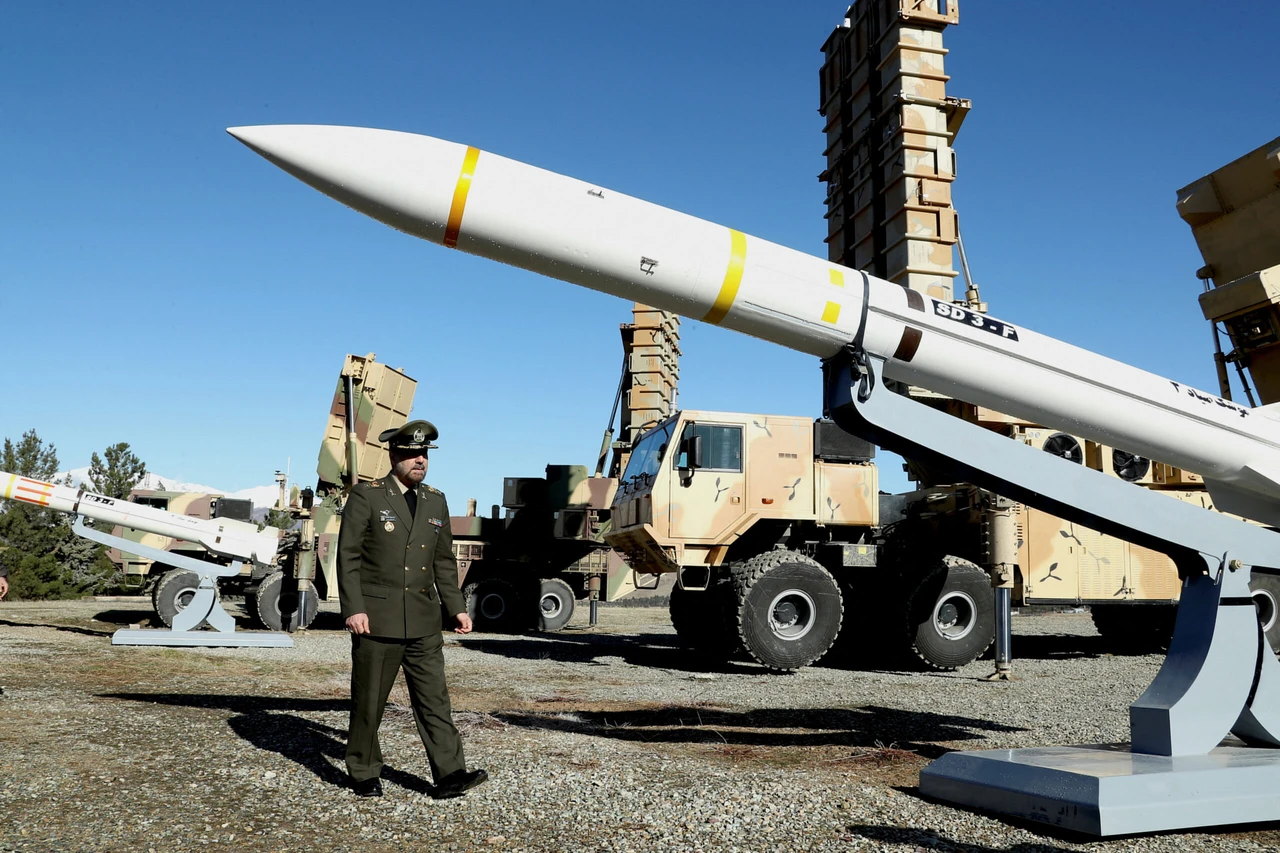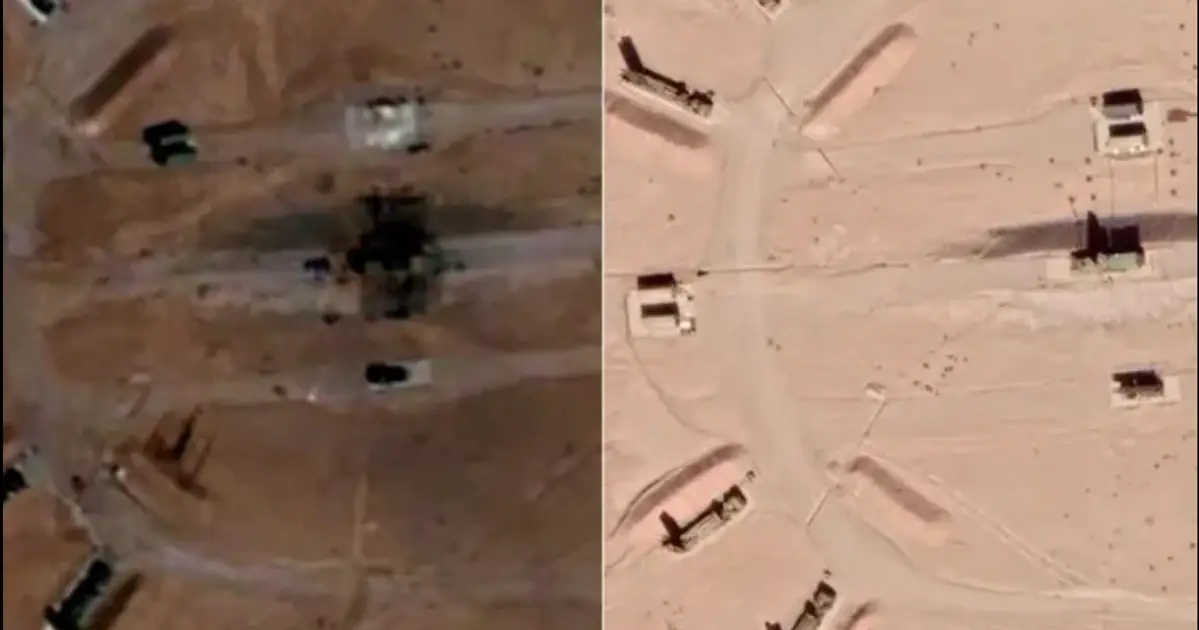Iran’s air defense failed? Haniyeh assassinated by alleged Israeli missile
 Iran's Defense Minister Brigadier General Mohammad-Reza Ashtiani walks near an Iranian missile during an unveiling ceremony in Tehran, Iran, on February 17, 2024. (Photo by Iran's Defense Ministry)
Iran's Defense Minister Brigadier General Mohammad-Reza Ashtiani walks near an Iranian missile during an unveiling ceremony in Tehran, Iran, on February 17, 2024. (Photo by Iran's Defense Ministry)
Palestinian resistance group Hamas announced that its political bureau chief Ismail Haniyeh was killed in an Israeli airstrike targeting his residence in the Iranian capital Tehran.
Without satellite images, it’s difficult to determine the type of ammunition used to kill Haniyeh. However, Israel possesses all the necessary assets to conduct such an operation. This includes airborne early warning and control (AEW&C) aircraft, electronic warfare aircraft, aerial refueling tankers, low radar signature aircraft, long-range munitions, and significant intelligence capabilities. Therefore, it’s possible that Israel could execute a highly risky and complex operation of this nature.
It should be also noted that Israel’s intelligence Mossad can also conduct such assassination operations inside Iran’s territory. For example in 2022 an officer in Iran’s Islamic Revolutionary Guard Corps (IRGC) was shot dead by unknown assailants on a motorcycle outside his home in east Tehran.
In 2010, top Iranian nuclear scientist Mohsen Fakhrizadeh was assassinated in a sophisticated hit led by a Mossad team that reportedly deployed and used a computerized machine gun system.
Between 2010 and 2020, five Iranian nuclear scientists (Masoud Ali-Mohammadi, Majid Shahriari, Darioush Rezaeinejad, Mostafa Ahmadi Roshan, and Mohsen Fakhrizadeh) were killed in assassinations. Rezaeinejad was shot dead by gunmen on motorcycles, while Shahriari and Ahmadi Roshan were killed by explosives attached to their cars. Fereydoon Abbasi was also targeted in a car bombing but survived.
This is not the first time
Around 4 a.m. on April 19, 2024, the Isfahan province of Iran was rocked by three powerful explosions. Israel’s missiles reached deep into Iranian territory, again. Just six days after Tehran’s drone and missile attack on Israel that we have witnessed.
U.S. sources report that three missiles were launched toward Isfahan’s Eighth Shekari Air Base from outside Iran’s airspace, breaching its air defense shield. Satellite imagery showed damage to the engagement radar, a crucial component of Iran’s S-300 air defense systems.

This incident exposed vulnerabilities in Iran’s air defense systems and raised concerns about their ability to protect key assets in Iran.
Iranian Air Defense Missile Systems
The following systems are used by the Islamic Revolutionary Guard Corps Aerospace Force (IRGCASF) and the Islamic Republic of Iran Air Defense Force (IRIADF):
- Raad-1 (SAM): Uses Taer-1 (50 km), 3M9/9M9 Kub (24 km) missiles to operate. Categorized as a medium-altitude defense system, the system employs a combination of radar and electro-optical (EO) tracking to guide its missiles up to 50 km. Each battery has five transporter erector launchers (TELs) and a fire control unit.
- Mersad-1/2, Qader surface-to-air missile (SAM): Uses Shahin, Shalamcheh, and Sayyad-2 missiles to operate. Categorized as a low and medium-altitude defense system, the system can be paired with Najm-804 (or mobile Kavosh search radar, 110-150 km) and Hafez (110-250 km detection and 80 km tracking range) long-range phased array 3D search radars. Qader is the truck-mounted mobile version. Associated reverse-engineered radars reportedly include the Kashef, Jooya, and Haadi, a high-power illuminator radar (HPIR) with an 80 km range.
- Ya Zahra-3 (SAM): Uses Shahab-e Thaqeb missile to operate. Categorized as a low-altitude defense system, the system is an Iranian copy of the Chinese semi-mobile FM-80, which is itself a copy of the French Crotale. Beam-rider radar guidance with EO tracking.
- Herz-eh Nohom (SAM): Uses Shahab-e Thaqeb missile to operate. Categorized as a low-altitude defense system, it is a fully mobile version of Ya Zahra with passive radar guidance and EO tracking.
- Raad-2 (SAM): Uses Taer-2A missile to operate. Categorized as a medium-altitude defense system, the system is coupled with a Sepehr-14 EO passive tracking system (55-80 km range) and passive homing (missile).
- Tabas (SAM): Uses Taer-2A/2S and 3M9/9M9 Kub (24 km) missiles to operate. Categorized as a low and medium-altitude defense system, the system can be linked with Bashir search radar. It has a full battery that can reportedly fire eight missiles simultaneously at four targets.
- Khordad-3 (SAM): Uses Taer-2/2B, Sayyad-2/2C/ 2CM and Taer-3 (ER) (2022) missiles to operate. Categorized as a medium and high-altitude defense system, the system uses a mix of TELs and transporter erector launchers and radars (TELARs). In September 2022, a larger, heavier TEL with four boxed missile canisters was unveiled. With an active array search and fire-control radar, it was reportedly used to shoot down a U.S. RQ-4 drone over the Strait of Hormuz and can operate independently. Recently equipped with EO day/night tracking system, the system can be linked with Bashir S-band search radar with a 350 km detection range. It has missiles in active radar and command-guided versions. Its trial was conducted on the deck of a ship in 2020.
- Talash-1 (SAM): Uses Sayyad-2 missile to operate. Categorized as a medium and high-altitude defense system, the system can be used to protect high-value assets against a variety of aerial targets. It can be linked with S-200’s K-1 Square Pair engagement radar (270 km range).
- Sayyad (SAM): Uses Sayyad-2 and Sayyad-3C missiles to operate. Categorized as a medium and high-altitude defense system, the system is a variant of Talash, with Najm-804 X-band target acquisition and engagement phased array track-while-scan (TWI) radar with 150/100 km range and Sayyad fire-control radar.
- Misagh-3 man-portable air-defense systems (MANPADS): The operating missile is currently unknown but it is categorized as a low-altitude defense system. It includes a laser proximity fuse and a 5 kg warhead. It is a licensed copy of Chinese QW-1 MANPADS.
- Talash-2 (SAM): Uses Sayyad-2 and Sayyad-3 missiles to operate. It is categorized as a medium and high-altitude defense system.
- Talash-3 (SAM): Uses Sayyad-2 and 5V21 (S-200) missiles to operate. Categorized as a medium and high-altitude defense system, it is the upgraded S-200 with new radar and missiles.
- Talash-4 (SAM): It uses the Sayyad-3C missile and is categorized as a medium and high-altitude defense system. It was likely developed into the Khordad-15 and is claimed to have the ability to engage ballistic and semi-ballistic missiles. The system includes the Ofogh fire-control radar, which can engage low-radar-cross-section (RCS) targets. It can replace the S-200 system. The Sayyad-3 reportedly has both semi-active and active homing modes.
- Item 358 (air defense cruise missile): Item 358 (air defense cruise missile) is a low and medium-altitude defense system. While the operating missile is currently unknown, it is jet-powered and designed to counter drones and helicopters. It is launched using a rocket booster and then tracks its target using inertial and satellite navigation along with EO homing. The missile detonates either upon impact or via an optical or laser proximity fuse array. It has been shipped to the Houthis since at least 2018 and is also in service with Iraqi militias, Hezbollah, and PKK/YPG.
- Khordad-15 (SAM): It uses Sayyad-2, Sayyad-3C, and Sayyad-3 missiles and is categorized as a medium and high-altitude defense system. Operated by the IRIADF, it is a major upgrade of the Talash system and was first fielded in November 2021. This “quick reaction system” is equipped with the Najm-802 phased array radar and is claimed to detect stealth aircraft at 85 km and track them at 45 km. It can also track and engage drones, ballistic missiles, and cruise missiles. The Khordad-15 is designed to protect large cities and critical infrastructure.
- Bavar-373 (SAM): The Bavar-373 (SAM) uses Sayyad-2, Sayyad-3, Sayyad-4, and Sayyad-4B missiles and is categorized as a high-altitude defense system operated by the IRIADF. It is reportedly under upgrade. This vertical-launch “air dominance” weapon claims the ability to track and engage high-altitude and stealth aircraft, helicopters, drones, and anti-radiation, ballistic, and cruise missiles with 360-degree coverage. It includes a command vehicle, search radar, engagement radar, and up to six launchers with four rounds in separate canisters. It can be paired with the Sairan Meraj-4 (M-4) active array S-band radar, which has a claimed detection range of 450 km and detection altitude of 130 km, and can detect ballistic missiles at 1,200 km. Its LPIAESA fire-control radar has a maximum detection range of 320 km and a tracking range of 260 km. The system can also receive targeting data from the Alim passive radar.
- Madjid: The system uses AD-08 (IIR) missile system. It is categorized as a low-altitude defense system operated by the IRIADF. It is a pickup-truck-mounted point-defense system designed to counter cruise missiles and drones, featuring EO search and tracking capabilities. It can be linked to the Kashef-99 search radar and carries up to four missiles equipped with imaging-infrared seekers.
- 9th of Dey: The 9th of Dey system uses the 9th of Dey missile and is categorized as a low-altitude defense system operated by the IRGCASF. It is a new version of the Khordad-3, featuring up to eight boxed short-range, command-guided missiles with laser-proximity fuses. Each battery includes four mobile launchers. The system uses radar and EO guidance linked to the Qods long-range (500 km) target acquisition radar. It is capable of engaging stealth drones, helicopters, cruise missiles, and standoff munitions, and is designed to counter large-scale missile attacks.
- Mersad-16: The Mersad-16 system uses the Shalamcheh-2 missile and is categorized as a low and medium-altitude defense system operated by the IRIADF. It is highly mobile and features a remote-controlled triple launcher with the Hafez phased array target acquisition radar, which has a range of 250 km. The system is designed to counter fast, low-flying targets such as cruise missiles and drones. A high-altitude version is currently under development.
- Dezful: The Dezful system uses the 9M331 missile or a local copy and is categorized as a low-altitude defense system used by the IRGCASF. It is an anti-cruise missile and drone system, truck-mounted with Tor-M1 radar and EO/thermal imager. In April 2022, the IRIADF unveiled a version mounted on a larger truck.
- Jowshan (passive Khordad-15): The system is an upgraded version of the Khordad-15. It employs an unknown missile and features passive radar and missile guidance systems. Its precise categorization is not possible due to the lack of information about the missile used.
- Zoobin: Categorized as a low and medium-altitude defense system, this advanced all-in-one mobile point-defense system uses an unknown missile. It features 360-degree coverage with a vertical launcher for eight missiles and is capable of intercepting low-flying aircraft, suicide drones, cruise missiles, and standoff munitions. A naval version is likely in development.
(Source: The Washington Institute)
All these air defense systems failed to prevent Israel’s alleged aerial strike against Ismail Haniyeh’s residence in Tehran. It is important to note that Israel has the capability to conduct such an operation. For example, this could be executed using Israel’s F-15I Ra’am and F-35I Adir aircraft.



